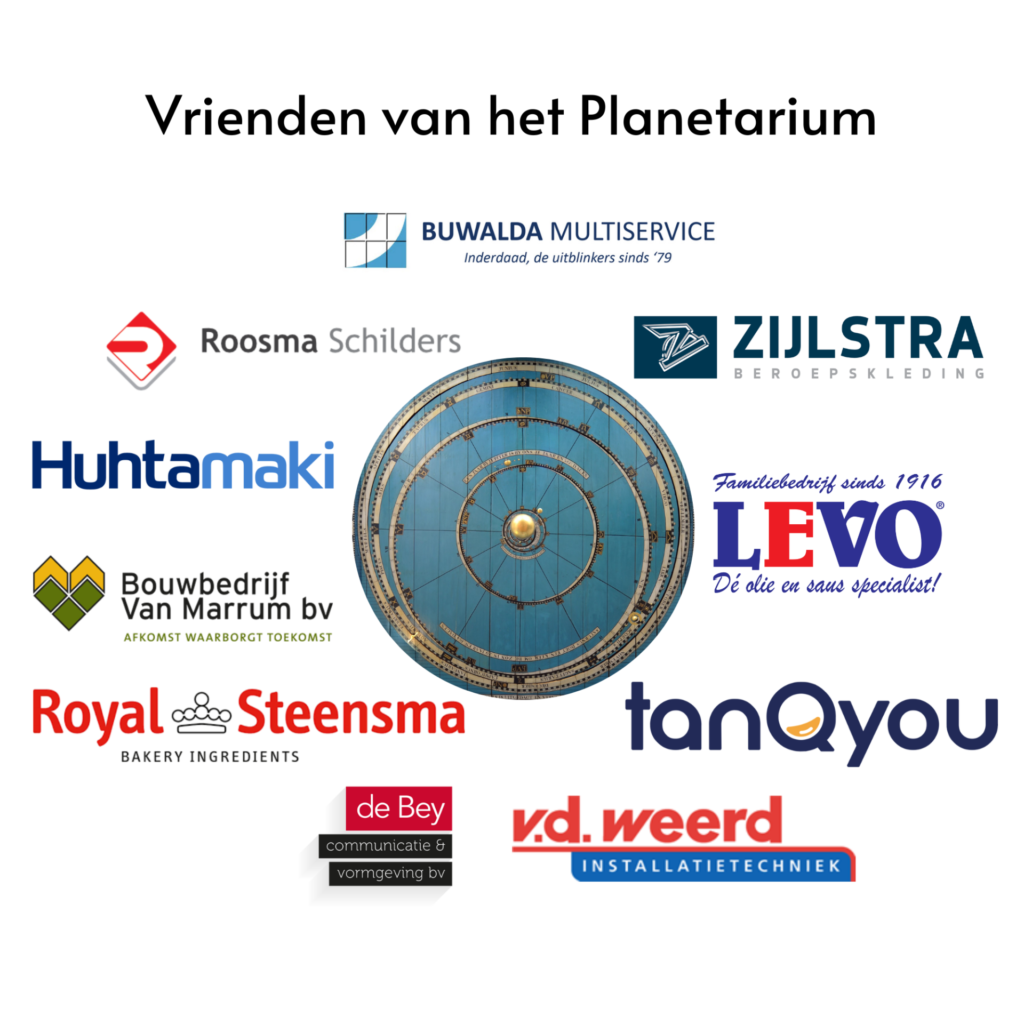Planetariumroom
The Planetarium Room is the centrepiece of the Eise Eisinga Planetarium. The model of the sun with the 6 planets turning around it still functions. This makes it the oldest working planetarium in the world. During your visit, you will be given plenty of information in the Planet Room. This explanation will take about 15 minutes. You can discover the rest of the museum, including the radar on your own.
Permanent exhibitions
Other permanent parts of the museum include Eisinga’s former wool combing establishment and an extensive collection of historical astronomical instruments. Modern astronomy is also represented. Non-stop documentaries are shown in the screening room. Experience how Eisinga lived in the historic house and digitally browse through Eisinga’s beautiful mathematical and astronomical manuscripts! The interactive permanent exhibition ‘De Ruimte’ [Space] has been open to the public since 2016.
Temporary exhibition
The Astronomic Cabinet of Paulus and Ghiesbregt
A spectacular astronomical cabinet from 1771 by Jean Paulus and Prof. Ghiesbregt is currently set up in the temporary exhibition space. After long wanderings, this Belgian instrument came into possession of Bert Degenaar, a famous Dutch antique collector. On his behalf, the instruments were completely restored and made functional again by horologist Pieter de Ruiter.
The 3 meter wide and over 2.5 meter high cabinet is equipped with various globes, planetariums (including an unprecedented representation of the 5th-century worldview of Martianus Capella) and the 16th-century heliocentric worldview of Copernicus. A number of dials provide information about various time indications, calendars, the position of the planets, the phases of the moon, the orbit of Jupiter’s four largest moons and much more. The exposition also includes a large collection of original drawings of the various instruments.
Friends of the Planetarium foundation
The Friends of the Planetarium Foundation helps collect extra financial resources. This allows the foundation to make purchases, carry out restorations and conduct publicity campaigns for the Eise Eisinga Planetarium. All contributions are welcome!
Become a donor!
- an introductory gift in the form of the book ‘Timeless Solar System’, about the Eise Eisinga Planetarium
- at least once a year an invitation to a lecture/presentation
- a personal donor card, which gives you free access to the Planetarium for one year

You can sign up by sending an e-mail to info@eisinga-planetarium.nl or sending a message to the address below.
Stichting Vrienden van het Planetarium
Eise Eisingastraat 3, 8801 KE te Franeker
Bank account number: NL19RABO0144973197
When you sign up by transferring the correct amount, remember to mention your address details in the description.
Your application is greatly appreciated; gifts and bequests are also very welcome.
Thank you!
Eise Eisinga Planetarium UNESCO world heritage!
The Royal Eise Eisinga Planetarium is officially UNESCO world heritage. This means that the World Heritage Committee of UNESCO recognizes the exceptional universal value of this impressively large model of our solar system, which was made between 1774 and 1781 by the Frisian wool manufacturer and amateur astronomer Eise Eisinga.
The Eisinga Planetarium provides a current and realistic picture of the positions of the sun, moon, earth and the five other planets that were known at the time. The mechanism, which is built into the ceiling of Eisinga’s living room and bedroom, consists of simple but robust parts, such as wooden hoops and discs, and iron pins. The whole thing is controlled by one single movement. The instrument still has the function that Eisinga had in mind at the time. It has been used for almost 250 years to explain to visitors the workings of our solar system. This makes it the oldest working planetarium in the world.
Exceptional scientific heritage
ICOMOS, the international advisory body for UNESCO World Heritage, concludes in its report that the Eisinga Planetarium is of ‘outstanding universal value’ – a crucial condition for obtaining World Heritage status. ‘The Royal Eise Eisinga Planetarium is an excellent example of a technological ensemble that shows a moving scale model of the solar system as it was known at the end of the eighteenth century. It clearly illustrates a special moment in the history of science and in the understanding of the heliocentric model of the solar system.”
The Eisinga Planetarium is the thirteenth World Heritage Site in the Kingdom of the Netherlands. Three of them are located – completely or partially – in the province of Fryslân.
Unique and irreplaceable
World Heritage is considered unique and irreplaceable. A place on the World Heritage List therefore entails the obligation to preserve the heritage for future generations. In addition to the international protection that a heritage receives through inclusion on the UNESCO World Heritage List, this status also promotes understanding between cultures.

